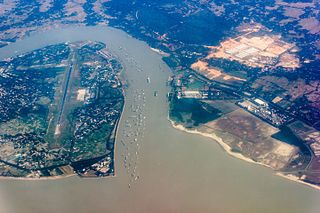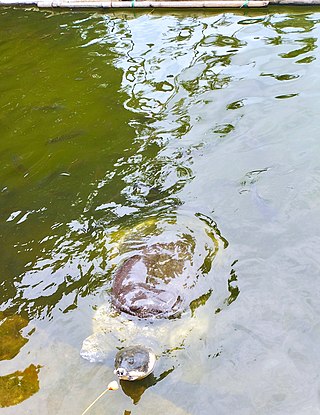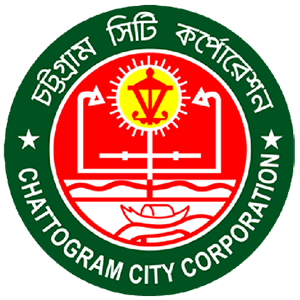
The Karnaphuli River is the largest and most important river in Chittagong and the Chittagong Hill Tracts. It is a 667-metre (2,188 ft) wide river in the south-eastern part of Bangladesh. Originating from the Saithah village of Mamit district in Mizoram, India, it flows 270 kilometres (170 mi) southwest through Chattogram Hill Tracts and Chattogram into the Bay of Bengal. It is the fastest flowing river in Bangladesh, after the Padma. It is said to "represent the drainage system of the whole south-western part of Mizoram." Principal tributaries include the Kawrpui River or Thega River, Tuichawng River and Phairuang River. A large hydroelectric power plant was built on the Karnaphuli in the Kaptai region in the 1960s. The mouth of the river hosts the Port of Chattogram, the largest and busiest seaport of Bangladesh.

Abū Yazīd Ṭayfūr bin ʿĪsā bin Surūshān al-Bisṭāmī (al-Basṭāmī), commonly known in the Iranian world as Bāyazīd Bisṭāmī, was a Persian Sufi from north-central Iran. Known to future Sufis as Sultān-ul-Ārifīn, Bisṭāmī is considered to be one of the expositors of the state of fanā, the notion of dying in mystical union with Allah. Bastami was famous for "the boldness of his expression of the mystic’s complete absorption into the mysticism." Many "ecstatic utterances" have been attributed to Bisṭāmī, which lead to him being known as the "drunken" or "ecstatic" school of Islamic mysticism. Such utterance may be argued as, Bisṭāmī died with mystical union and the deity is speaking through his tongue. Bisṭāmī also claimed to have ascended through the seven heavens in his dream. His journey, known as the Mi'raj of Bisṭāmī, is clearly patterned on the Mi'raj of the Islamic prophet Muhammad. Bisṭāmī is characterized in three different ways: a free thinking radical, a pious Sufi who is deeply concerned with following the sha'ria and engaging in "devotions beyond the obligatory," and a pious individual who is presented as having a dream similar to the Mi'raj of Muhammed. The Mi'raj of Bisṭāmī seems as if Bisṭāmī is going through a self journey; as he ascends through each heaven, Bisṭāmī is gaining knowledge in how he communicates with the angels and the number of angels he encounters increases.

Chittagong District, renamed the Chattogram District, is a district located in south-eastern Bangladesh. It is a part of the Chittagong Division. The port city of Chittagong, which is the second largest city in Bangladesh, is located within this district.

The black softshell turtle or Bostami turtle, previously placed in genus Aspideretes, is a species of freshwater turtle found in India and Bangladesh. It was long believed to consist of inbred individuals of the Indian softshell turtle or the Indian peacock softshell turtle, but while it is a close relative of the latter, it is a distinct species. In the 1800s it was believed these turtles were brought from Iran to Chittagong shrine pond by Hazrat Bayezid Bostami. His turtles he had brought to this pond were treated as sacred and respected by the public. Previously declared extinct by the International Union for Conservation of Nature in 2002, these turtles were found still to exist in a temple's pond called the Hayagriva Madhava Temple located in Assam, and in Kalyan Sagar lake in Tripura Sundari Temple in Udaipur, Tripura, India. Through conservation methods and protection of the species, some of these turtles can be found today throughout the wild, and scientists and environmental biologists are continuing to work hard to preserve this endangered species and their natural habitat. Their mitogenome represents relatedness to 19 other species of the Testudines. When looking at the phylogenetic tree, Nilssonia nigricans is a sister group to Nilssonia formosa.

Indian peacock softshell turtle is a species of turtle found in South Asia and is listed on the IUCN Red List as a vulnerable species.

The Indian softshell turtle, or Ganges softshell turtle is a species of softshell turtle found in South Asia in rivers such as the Ganges, Indus and Mahanadi. This vulnerable turtle reaches a carapace length of up to 94 cm (37 in). It feeds mostly on fish, amphibians, carrion and other animal matter, but also takes aquatic plants. This turtle is listed in part II of Schedule I of the Wild Life (Protection) Act, 1972 and possession of this species is an offence.

Chattogram City Corporation (CCC) is a self-governing body that governs the municipal areas of Chattogram and some adjoining areas of south-eastern Bangladesh. The CCC government is elected by popular vote every five years.

Anowara, also written Anwara, is an upazila of Chattogram District in Chattogram Division, Bangladesh.

Chattogram Bandar is a thana of Chattogram District in Chattogram Division, Bangladesh.

Hathazari is an upazila of Chattogram District in Chattogram Division, Bangladesh.

Sandwip is an upazila of Chattogram District in Chattogram Division, Bangladesh. It encompasses the islands of Sandwip and Urir Char.
Chattogram Kotwali is a thana of Chattogram District in Chattogram Division, Bangladesh.

Nilssonia is a genus of softshell turtles from rivers, streams, ponds, and lakes in South Asia and Burma. In many treatments, it is monotypic, with the single species Burmese peacock softshell. However, the supposed other genus of peacock softshells, Aspideretes, is more closely related to N. formosa than had been believed. They differ only in the neural plates between the first pleural scale pair of the bony carapace, which are fused into one in N. formosa and unfused in the others.

Wali Khan Mosque is an 18th-century mosque located in Chittagong, Bangladesh. It is situated in the Chawk Bazar area of the city.

Tourism in Bangladesh includes tourism to World Heritage Sites, historical monuments, resorts, beaches, picnic spots, forests, tribal people, and wildlife of various species. Activities for tourists include angling, water skiing, river cruising, hiking, rowing, yachting, beachgoing and sea bathing.

The city of Chattogram (Chittagong) is traditionally centred around its seaport which has existed since the 4th century BCE. One of the world's oldest ports with a functional natural harbor for centuries, Chittagong appeared on ancient Greek and Roman maps, including on Ptolemy's world map. Chittagong port is the oldest and largest natural seaport and the busiest port of Bay of Bengal. It was located on the southern branch of the Silk Road. The city was home to the ancient independent Buddhist kingdoms of Bengal like Samatata and Harikela. It later fell under of the rule of the Gupta Empire, the Gauda Kingdom, the Pala Empire, the Chandra Dynasty, the Sena Dynasty and the Deva Dynasty of eastern Bengal. Arab Muslims traded with the port from as early as the 9th century. Historian Lama Taranath is of the view that the Buddhist king Gopichandra had his capital at Chittagong in the 10th century. According to Tibetan tradition, this century marked the birth of Tantric Buddhism in the region. The region has been explored by numerous historic travellers, most notably Ibn Battuta of Morocco who visited in the 14th century. During this time, the region was conquered and incorporated into the independent Sonargaon Sultanate by Fakhruddin Mubarak Shah in 1340 AD. Sultan Ghiyasuddin Azam Shah constructed a highway from Chittagong to Chandpur and ordered the construction of many lavish mosques and tombs. After the defeat of the Sultan of Bengal Ghiyasuddin Mahmud Shah in the hands of Sher Shah Suri in 1538, the Arakanese Kingdom of Mrauk U managed to regain Chittagong. From this time onward, until its conquest by the Mughal Empire, the region was under the control of the Portuguese and the Magh pirates for 128 years.
Bayazid Bostami is a thana of Chattogram District in Chattogram Division, Bangladesh. There are three wards in the Thana.

The fauna of Bangladesh includes about 1,600 species of vertebrate fauna and about 1,000 species of invertebrate fauna based on incomplete records. The vertebrate fauna consists of roughly 22 species of amphibians, 708 species of fish, 126 species of reptiles, 628 species of birds and 113 species of mammals. The invertebrate fauna includes about 30 species of aphids, 20 species of bees, 178 species of beetles, 135 species of flies, 400 species of spiders, 150 species of lepidopterans 52 species of decapods, 30 species of copepods, 2 species of starfish, and some species of sand dollars, sea cucumbers, and sea urchins.

Jalalabad is the No.02 Ward of Chattogram City Corporation and a part of Bayazid Thana, Bangladesh.

Panchlaish is the No. 03 Ward of Chattogram City Corporation and a part of Bayazid Thana, Bangladesh.























